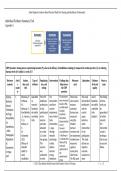Johns Hopkins Evidence-Based Practice Model for Nursing and Healthcare Professionals
Individual Evidence Summary Tool
Appendix G
EBP Question: Among nurses experiencing burnout (P), what is the efficacy of mindfulness training (I) compared to routine practice (C), in reducing
burnout levels (O) within 12 weeks (T)?
Reviewer Articl Author, Type of Population, Intervention Findings that Measures Limitations Evidence Notes to
name(s) e date, and evidence size, and help answer used level and team
numb title setting the EBP quality
er question
Krishna 1 Bhardwaj, P., Quantitati There 98 The The outcomes Three tools This study Level I: The finding
Dwivedi, Pathania, ve healthcare intervention were measured were used to did not blind Randomiz of these
M., research: professiona used here based on PQL measure participants ed waitlist study can
Swami and MBI which outcomes.
Vivekanan Bahurupi, Y., Randomiz ls who was the and the controlled be
included
Kanchibhotla ed waitlist participated implementa Burnout was control trials generalized
da Yoga Emotional
, D., Harsora, controlled in the tion of mind- measured group Quality A in further
Anusandha Exhaustion,
P., & trials exercise body Depersonalizati using the lacked an research.
na Rathaur, V. and were intervention Maslach active The
on and
Samsthana K. allocated s, yoga, Personal burnout intervention interventio
, India 01 on a ratio through accomplishmen inventory and for its n used a
Venugopal November 1:1 to the mhealth t. Bhardwaj et the statements participants. technique
Vijayakum 2023 two groups. technology al. indicate that included were The study that is easy
ar, Efficacy of This to help MBI and PQL measured did not use to use and
improved
Governme mHealth exercise address against a objective follow.
significantly in
nt Yoga aided 12- was burnout seven-point outcome
the
and week conducted among experimental Likert Scale. measures to
meditation in north healthcare group The PQL scale show
© 2021 Johns Hopkins Health System/Johns Hopkins School of Nursing Page |1
, Johns Hopkins Nursing Evidence-Based Practice
Individual Evidence Summary Tool (Appendix G)
EBP Question: Among nurses experiencing burnout (P), what is the efficacy of mindfulness training (I) compared to routine practice (C), in reducing
burnout levels (O) within 12 weeks (T)?
Reviewer Articl Author, Type of Population, Intervention Findings that Measures Limitations Evidence Notes to
name(s) e date, and evidence size, and help answer used level and team
numb title setting the EBP quality
er question
Naturopat and breath India at a professionals (p<0.001). measured collection
hy Medical intervention tertiary within the The meditation attitude and between
on change in care facility. institution. group sentiments of MBI
College, registered a
India burnout and Yoga was professional to component
decrease in
professional perceived as assess and
heart rate. In
quality of life an effective the control Compassion psychologic
among approach group, there satisfaction al or
health care that helped was a and burnout neurological
providers of to address a significant levels. impacts.
a tertiary couple of increase in Lastly, Omron
care hospital issues faced depersonalizati automatic
in north by HCPs such on, diastolic blood pressure
India: a as stress, and systolic BP monitor
and low
randomized depression registered the
personal
waitlist- and anxiety. participants
accomplishmen
controlled t was observed. blood pressure
trial. This was and heart
attributed to rates.
the increasing
demand in the
workplace
2 Cohen, C., Quantitati A total of The The authors The authors It was Level I The
Pignata, S., ve Meta 33 articles intervention noted that used a burnout impossible evidence: healthcare
Bezak, E., analyses: were s included organization- survey to perform Systematic workers
Tie, M., & Systematic included in were those based inventory meta- Review should
Childs, J. Review the review that focused interventions measure to analysis Quality A disclose the
© 2022 Johns Hopkins Health System/Johns Hopkins School of Nursing Page |2
, Johns Hopkins Nursing Evidence-Based Practice
Individual Evidence Summary Tool (Appendix G)
EBP Question: Among nurses experiencing burnout (P), what is the efficacy of mindfulness training (I) compared to routine practice (C), in reducing
burnout levels (O) within 12 weeks (T)?
Reviewer Articl Author, Type of Population, Intervention Findings that Measures Limitations Evidence Notes to
name(s) e date, and evidence size, and help answer used level and team
numb title setting the EBP quality
er question
after on that focused determine across the bigger
Accepted 23 removing workplace on observer studies picture of
May 2023 duplicates wellbeing professionals ratings and because the employee
and intervention well-being measure levels studies well-being
Workplace perfroming s. were more of burnout, included to help
intervention abstract They effective well-being and varied strengthen
s to improve screening. included: compared to anxiety of widely in research.
well-being - the nurses. their designs
and reduce Most mindfulness individually Studies that and data
burnout for studies based focused registered collection
nurses, were based practices approaches. objective pre methods.
physicians in US and -Peer The and post Few studies
and allied others were support interventions intervention met the
healthcare based in network helped to outcome inclusion
professionals Netherland -choir improve and measures were criteria.
:a s, Australia, singing maintain their included. The studies
systematic Japan, hong -Yoga well-being. were one-
review. Kong, Iran -Gratitude Studies sided with
and Brazil. journaling showed that the view of
The sample -Massage after the employee
size was chair interventions, well-being
between 9 -Job Crafting the thus
and 228 - healthcare difficult to
participants professional professionals determine
. coaching registered overall
Participant and, low levels of impact on
© 2022 Johns Hopkins Health System/Johns Hopkins School of Nursing Page |3




